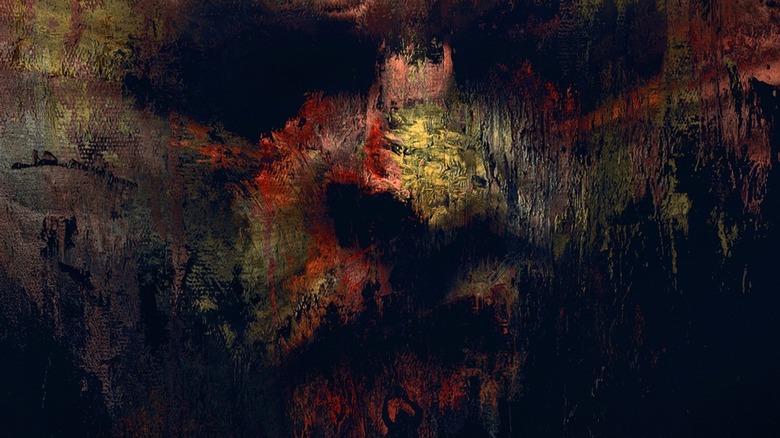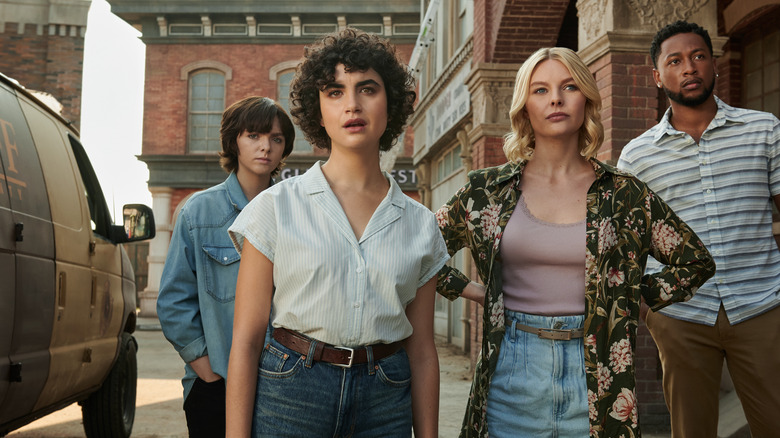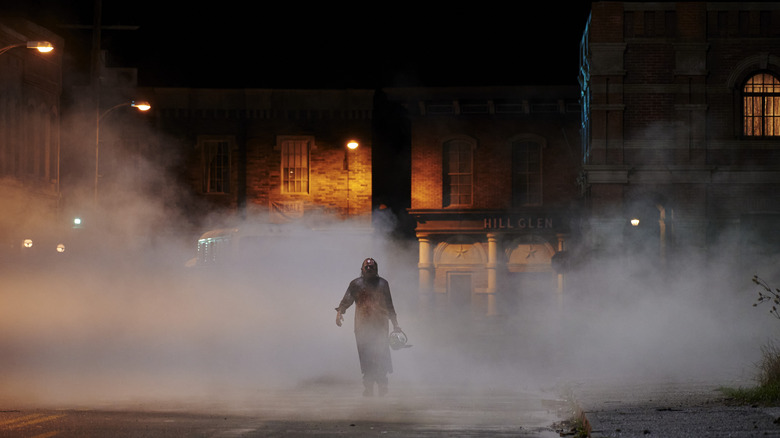Texas Chainsaw Massacre Review: Old Man Leatherface
A key thing all of the best "Texas Chainsaw" sequels have in common, at least for my money, is an inherent understanding that they're never going to replicate the feeling of the original film. Tobe Hooper and Kim Henkel's sweaty, docustyle descent into madness back in the Texas summer of 1974 still carries a layer of extra dread about it, a sense that you're not actually meant to watch what's onscreen because it's too visceral, too realistic, too evocative of the actual volatility that came with the making of that film. It's a feeling that's impossible to replicate, in part because it's not necessarily healthy to try, and the most successful sequels understand this. Whether they veer into outright lunacy like Hooper's own "Texas Chainsaw Massacre 2" in 1986, or into inventive reverence like 2013's "Texas Chainsaw 3D," these are films clever enough to borrow what they'd like to from the original concept, then push things forward into their own manic territory.
Which brings us to "Texas Chainsaw Massacre," the 2022 requel from producer Fede Álvarez and director David Blue Garcia which just landed on Netflix. Like "Texas Chainsaw 3D" before it, this film opts to take the approach of ignoring each previous sequel in the decades-old franchise, creating a world in which Leatherface rampaged through the Texas backwoods in the 1970s, only to then disappear into hiding until some unlucky bunch of youths disturbed his self-imposed exile. This buys the film an opportunity to build its own sense of lore around not just an aged Leatherface (Mark Burnham), but the first film's lone survivor, Sally Hardesty (Olwen Fouéré), all through the lens of a new cast and a new setting.
This is, for all its promise, a precarious setup, one that runs the risk of being a little too reverential to the original film and its world, leaving the new film with little room to run in its own direction. Thankfully for everyone, while it has its share of missteps, "Texas Chainsaw Massacre" takes every opportunity to go bigger than its predecessors, delivering a film that never quite loses sight of the original, but never clings too tightly to it either.
A bad business trip
As the film begins, a group of young entrepreneurs led by Melody (Sarah Yarkin) are on their way to the ghost town of Harlow, Texas, where they hope to build a ... well, a development utopia of some kind. Melody and her partner Dante (Jacob Latimore) are opening a restaurant in the town, and they're selling other buildings off to their fellow young entrepreneurs with the goal of building some vaguely communal new place where everyone can belong. It's all very buzz-wordy, very social media friendly, and perhaps a little shallow when you stop and think about it for a moment.
And of course, Melody and Dante didn't think too hard about Harlow itself, at least in terms of the ripple effect of their presence in the town. No one in the vicinity of the dead community seems all that happy to see them, and things get particularly dodgy when they arrive and find that at least one Harlow resident, an old orphanage manager (Alice Krige), isn't keen on leaving at all. As Melody wrestles with the moral implications of kicking this old woman out when they might not technically have the right to just yet, she and Dante also unknowingly awaken a monster. It seems that the killer known as Leatherface has been hiding in plain sight in Harlow for years, living in quiet seclusion, until what's left of his home life is shattered. Faced with everything he knows vanishing, the old mass murderer picks up his old weapons and tries to take back his town.
There's a two-pronged approach that comes with this setup, and one side works much better than the other, so let's get to the bad news first. "Texas Chainsaw Massacre" is very keen on the idea of vaguely satirizing and, in some moments, sincerely picking apart a certain kind of Gen Z-ish movement toward social change that sounds deeper than it actually is. Melody and Dante talk about freedom and inclusion and the evils of late stage capitalism, but they're also businesspeople who are nevertheless trampling someone else's home. Their investors arrive looking for authenticity, but are quick to envision a way in which they can strip Harlow of all that it once was. Then there's Melody sister Lila (Elsie Fisher), a school shooting survivor who seems to be present so the film can present some kind of vague exploration of trauma and how to overcome it through a fresh of wave of courage when a maniac with a chainsaw rises up. None of this feels actively bad, and some of it (like the moment in the trailer when a group of people with phones decide to try and "cancel" Leatherface by filming him) is genuinely funny, but it all feels rather limp in a "Halloween 2018 redux" kind of way, particularly when we see weathered old gunslinger Sally Hardesty gazing at a Polaroid of her friends who died back in the '70s.
Horror revved up
The film's early character development, and the efforts to create a juxtaposition between the faded world of Harlow and the vibrant life these young people imagine for the town, is all there to generate some level of investment in the inevitable. Your mileage may vary with regard to how well that investment works (it didn't work all that well for me), but the other main thrust of "Texas Chainsaw Massacre" picks up any slack that the character building left on the ground and runs with it in dizzying and often fascinating ways. All of which is a longer way of saying that, once Leatherface shows up, things get very wild very fast.
The original "Texas Chain Saw Massacre" is famously understated in its approach to violence, at least in terms of the actual gore onscreen. Its sequels have been a far cry from understated, and "Texas Chainsaw Massacre" sets out to make even the most extreme of those follow-ups look tame by comparison. Garcia's camera almost never spares the gore, delivering death scenes that are at turns cartoonish and cringe-inducing, but always inventive and morbidly fun to watch. As the trailers suggest, the film never holds back on the carnage or the body count, and both Garcia and his cast are clearly having the time of their lives soaking the screen in fake blood. At almost every turn, it works in the film's favor, delivering on the chainsaw-fueled mayhem the franchise has always promised.
It's in that mayhem, and the new ways in which the film plays with the familiar "youths in peril" formula of the franchise, that "Texas Chainsaw Massacre" hits its stride. After some questionable choices in the first act, the second and third just keep ramping up the horror, the tension, and the unpredictability, until the film becomes something equally at home at a rowdy drive-in or a candy-fueled slumber party. It might not resemble the original film all that much by the end (apart from a few sly sequences meant to mirror what came before), but that's exactly why it works. By revving up its own saw and cutting madly through what once was, "Texas Chainsaw Massacre" brings the franchise to bloody new life, giving Leatherface an unforgettable new chapter that, while uneven, carries an infectious sense of slasher fun throughout.
"Texas Chainsaw Massacre" is now streaming on Netflix.


